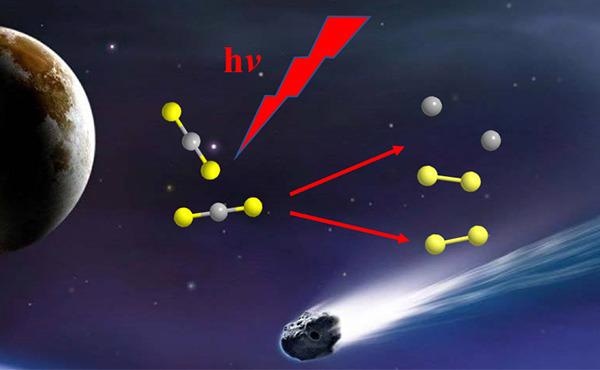Jan 29 2021
Gaining insights into interstellar chemistry requires the exploration of the development and evolution of sulfur-containing compounds in outer space.
 Researchers directly observed the C + S2 Channel in CS2 photodissociation. Image Credit: Zhenxing Li.
Researchers directly observed the C + S2 Channel in CS2 photodissociation. Image Credit: Zhenxing Li.
In interstellar dust, comet nuclei, or ice cores, CS2 is regarded to be the most crucial molecule. It has the potential to generate fragments of CS and S2 following photodissociation.
The emission spectra of only CS and S2 were observed by the International Ultraviolet Explorer satellite, but not that of CS2. The mechanism behind the photodissociation of CS2 molecules is still unclear, and S2 fragments have not been experimentally observed previously.
Headed by Prof. Kaijun Yuan at the Dalian Institute of Chemical Physics (DICP) of the Chinese Academy of Sciences (CAS), in collaboration with Prof. Xing’an Wang’s group at the University of Science and Technology of China, a team of researchers recently observed, for the first time, the C + S2 product channel from the photodissociation of CS2.
The researchers achieved this by using a home-made Time-Sliced Velocity Map Ion Imaging (TS-VMI) experimental setup, which is based on the Dalian Coherent Light Source (DCLS).
Published in the Journal of Physical Chemistry Letters on January 11th, 2021, the study offers direct experimental evidence for the evolution of the S2 fragments in the interstellar medium observed before.
The team analyzed the one-photon vacuum ultraviolet (VUV) and two-photon ultraviolet (UV) photodissociation dynamics of CS2 molecules by using the VUV free-electron laser (FEL) at DCLS.
They observed the C + S2 product channel from the photodissociation of CS2 directly and acquired images of the electronically ground/excited states of S2 products through vibrational excitation. The electronically excited states of the CS2 molecule’s central atom played a crucial role in the photodissociation and isomerization processes.
This study showed that the S2 fragments in the interstellar medium could be produced directly from the photodissociation of CS2.
Given the similarity of OCS studied in our previous works and CS2 in this work, we believe that the central-atom elimination channel is more general than expected in the photodissociation of triatomic molecules.
Kaijun Yuan, Professor, Dalian Institute of Chemical Physics, Chinese Academy of Sciences
This study was financially supported by the Chemical Dynamics Research Center, the National Natural Science Foundation of China, and the Key Technology Team of CAS.
Journal Reference:
Li, Z., et al. (2021) Direct Observation of the C + S2 Channel in CS2 Photodissociation. Journal of Physical Chemistry Letters. doi.org/10.1021/acs.jpclett.0c03386.